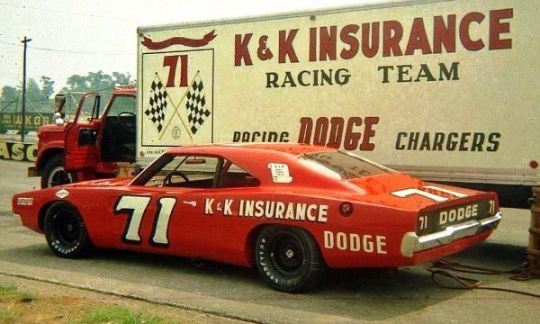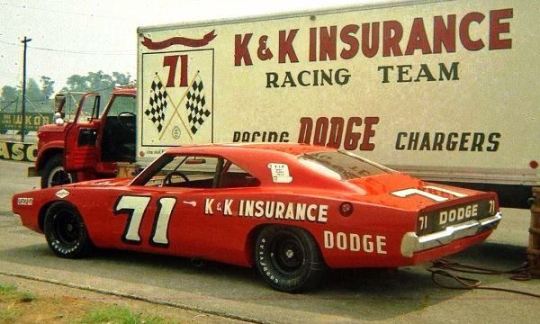#Nord Krauskopf
Text
A Test of Man and Mopar
I made this video edit of another watercolor painting; Based on Bobby Issac's record setting drive down the Bonneville Salt Flats with the soon to be retired Dodge Daytona Charger.
#Bobby Isaac#NASCAR#USAC#Mopar#Dodge#MoparMuscle#Nord Krauskopf#Hemi#Dodge Daytona#Daytona Charger#September 1971#Speed Records#Harry Hyde#Watercolor Painting#Bonneville Salt Flats#1969 Dodge Charger#Land Speed Records#K&K Insurance#K&K Insurance Racing#Bonneville#Utah#Muscle Car#Traditional Art#Traditional Art Video
2 notes
·
View notes
Photo

Bobby Isaac driving the number 71 owned by Nord Krauskopf.
84 notes
·
View notes
Text
Bobby Isaac’s Legendary #71 Dodge Daytona Returns to Bonneville
The Ghost of Bobby Isaac
“If you mashed it at 180 MPH, it would still break the back tires loose,” said Tim Wellborn, recalling what had just happened.. “You have to remember, we have 102 more cubic inches than they had back then––528 versus 426. Still, it was solid at that speed; it was planted to the salt and I could drive it with one hand.”
He had taken the original K&K Insurance-sponsored 1969 Dodge Charger Daytona from Alabama to Bonneville for demonstration runs, and managed to push it to the limits of its tires, noting there was a bunch left.
The #71 Charger Daytona in the Bonneville sunrise, recreating a view that had originally been witnessed one time before, back in 1971.
Once described by his crew chief Harry Hyde as resembling a bullfrog, legendary NASCAR driver Bobby Isaac’s road to fame did not come from the physical attraction many drivers must possess today. A hard scrabble upbringing in the hills of North Carolina and teenage work replacing a high school education also meant that Isaac did not come onto the scene with a wheelbarrow full of dollars, also a prerequisite for a top ride now. He was true old-school, cut from the same bolt as good ol’ boys like Lee Roy Yarbrough, Cotton Owens and Tiny Lund, into the Grand National series of Bill France’s NASCAR circuit.
Tim Wellborn and the truly priceless vintage Daytona racecar as the team gets ready for the next batch of runs.
Driving for Bondy Long, Junior Johnson, Bud Moore and even a single event in 1963 with Smokey Yunick, helped his notoriety, but Isaac’s main benefit was being on hand as the 426 Hemi arrived, thanks to getting into a factory Chrysler ride with builder Ray Nichols in 1964. His association with Mopars would run through the early 1970s, particularly after teaming up with Hyde and Nord Krauskopf, whose K&K Insurance company insured many racetracks. Isaac won the 1970 Grand National title, driving the #71 Dodge Daytona on superspeedways during the only full season they were legal.
In 1971, NASCAR rewrote a large number of rules due to several factors: changes in Detroit corporate leadership eliminating involvement, a desire to return to more conventional-appearing cars, reduction in engine displacements in other forms of racing, and more. The Daytona and other aero-specials were made uncompetitive by requiring engines no greater than 305-ci, resulting in champion Isaac and the #71 running only an abbreviated schedule for the season. However, the wing made one last shot at history, but not on the high-banks. Isaac and Hyde and all their years of dirt-track racing led them to the wilds of the Bonneville Salt Flats.
“Oh, yeah, that body was tricked out for the salt,” recalls Buddy Parrott today, who was there. He later went on to become a noted NASCAR crew chief, and was with Wellborn for this event. “We had the windshield molded in, the A-pillars all swigged up and everything. (Crew member) Robert Gee spent days slicking that car up, filling in cracks and stuff, and making it as aerodynamic as we could. When we broke a windshield out there, we had to tear all that bondo’d stuff out. We ended up running one record with the windshield just taped in.”
In a calmer venue, the K&K Daytona is perhaps the most treasured vehicle in the Wellborn Musclecar Museum’s collection, seen here with a rotating cut-away 426 Hemi display engine.
Among those on hand in mid-September 1971 for the series of world record land-speed attempts were Parrott, crew chief Hyde and his son Harry Lee, just back from a stint in the Marines in Vietnam. Noted Chrysler aerodynamicist George Wallace took his two weeks of paid vacation to be there as well. For four days USAC’s chief timer Joe Petrali recorded the efforts, which include production vehicle acceleration and endurance numbers. Most impressive was the measured 100-mile record on a ten-mile oval flat track that Isaac expertly handled, sideways, at 200 mph with rooster-tails flying.
“I was up on the stepladder watching the car and at one point I jumped off fast,” recalls Parrott. “Harry Lee said, ‘What’s wrong? What’s wrong?’ I said that car is going to run us all over, everybody run to the left, inside the track. The nose of that car was pointed right straight at us because of the yaw, but the car was totally sideways. We tore rubber off the tires out there like you would not believe; we had the superspeedway race slicks; the tires we called Talladega tires on it. Just like you blister them today. We did not have to change tires on the 100-mile run, but those engineers were all there with paper trying to calculate when it would run out of gas. Harry said, ‘let’s just bring it in early so we don’t have that problem and need to go and get it!’”
New world closed course records came from those 100-mile and 100-kilometer measured circuits, many in multiple classes. Bobby clocked 216.945 in the flying mile, and 182.174 in the standing start 10-mile trap to set new records in American Stock Car Class B, as well as several other international and unlimited class records. Isaac ended up with 28 records total, despite two car-damaging incidents during the marathon. Petrali, who had seen it all, would later say, “Nobody has ever done what this man just did!”
Nothing like being able to leave burnout marks on the salt flats; had record-setting been possible the conditions were excellent.
Ken Troutt, who was also on hand for the 2016 running with Parrott, was another young man working for Hyde at the time, but he did not make the trip back then.
“Yeah, I sort of had an option,” he admits. “I had this hot love affair going on with this little college nurse and a car show to go to with my T-bucket, so I asked Harry if he really needed me out there, and he said, ‘no, we’ll be fine.’ So I did miss that first time, and what kept me away was two hotties, my hot rod and my hot date. I missed my 50th high school reunion on September 17th to be out here this time.”
Records complete, that might have been the end of the story, but Harry Lee later recalled every single extra part they brought in the truck rusted in the next six months; the wing ended up tucked behind the shop as a reminder of better days. At Nord’s direction, the team donated the car to the International Motorsports Hall of Fame in Talladega in 1975 as that collection was being established. They cleaned it up, installed a dummy motor, and there it sat for two decades, complete with its added streamlining done for the record attempts.
As for Isaac, his career was varied following the 1970 season. Petty Enterprises got the Chrysler race business of Nichols as part of Richard’s return to Plymouth, a fact Harry Hyde disapproved of. Isaac won his last title at Rockingham in 1972, but was better noted for vacating the seat of Moore’s Ford in the middle of the 1973 Talladega 500, saying he heard voices telling him to park it. Unfortunately, that premonition was most likely part of his undetected heart issues, ones that later claimed his life following heat stress at the short-track nearest his home, Hickory Motor Speedway. Bobby Isaac died August 13, 1977.
Yes, those fender scoops proved to be exactly what Chrysler engineering quietly noted them for: air extraction––and a little bit of Bonneville dust…
“As a kid, I saw this car race at its first event, Talladega 1969, and have always been a fan of Bobby Isaac,” says Wellborn. “When I bought my first Daytona in 1976, I painted it orange, swapped a Hemi into it, and put the 426 CI lettering on the hood; I still have that car today. So, having driven the real car in Europe, and in exhibitions here, this was a dream I never thought I would do. I always wondered what it would be like to be at the salt flats, but Bonneville was the one place I never thought I would get to go.”
The Wellborns, whose noted Mopar collection is world-renown, have been long-time supporters of the museum. Tim is a member of its board, and was eventually allowed to own the #71 K&K Insurance Dodge after being given permission to get it running for a pair of European tours under the aegis of DiamlerChrysler. This was an effort by the German-based ownership at the time to show how Chrysler was involved in racing prior to the Viper. After Roger Gibson went through the car, Bob Lutz presented Wellborn with the first built-up 528-ci HEMI engine Mopar planned to release in crate form. Tim, his wife Pam, and the car appeared at Silverstone, Goodwood, even on the Nurburgring. Between then and 2016, the car had been to a number of exhibition circle track events and displayed at national museums, but a request from NASCAR would offer a chance to return to the salt 45 years to the day of its record setting efforts in 1971.
Chrysler’s unique bathtub intake allowed for hood clearance with the cowl induction air-cleaner that was pretty exclusive to the wing car program.
“We had about three weeks to get ready,” Wellborn notes. “NASCAR contacted me and said, ‘we know you have this car, and we would like to reenact the Bonneville Salt Flats portion of its history.’ My reply was, ‘absolutely!’ We had a madcap scramble to get the car ready. The show they did it for is called Race Hub, which runs on FS1, Fox Sports.” It aired October 26, 2016.
There would not be a lot needed to make the car ready, as Tim had recently run some laps with it at Atlanta Motor Speedway in late 2015. Fluids were changed and a fresh set of older, proper width Goodyear Speedway racing tires were added for the demonstration. There would be no 200-mph sideways sliding (‘it looked just like a hydroplane,’ Harry Hyde reminisced later), but straight-line action would be no problem. The film crew, former crew members Buddy Parrott and Ken Troutt, Parrott’s grandson Tyler, and Tim’s small entrourage including Joe Machado with a stock 1969 Dodge Charger Daytona, would be the only ones on hand to see the return.
“To do this thing in a car that I worked on 45 years ago, and to drive it out there was one of the highlights of my life,” says Troutt, a long time hot rodder. “That was the first car I worked on as a fabricator, and as the front tire pit crew man with the K&K team, along with Robert Gee, who was Dale Earnhardt Jr’s grand-daddy. I had been to Bonneville in the past, so this was very special for me. We explained to Tim some of the things that had been done to the car and why. To be honest, I don’t have words to describe it. Sort of like a ‘godsend’ as the King James Bible says, the greatest thing I’ve ever done.”
There was no official timing equipment set up so Tim calculated the speed based on tach RPM readings, something he is familiar with from the many times he has driven the car. He notes that the salt was a very unique environment, “We were out there for three days, practically to the day 45 years ago. Ken Troutt and Buddy Parrott were there to tell the stories. Then Buddy ended up having to work as my ‘pit crew’ when we had a tire go down. Ironically, that is something he also did when Bobby drove this car here back then; we didn’t plan on it! Beyond that, they told me what to expect – how the car might slide around, what I needed to do to keep it straight, things like that.”
Before getting underway, the special front spoiler was added. Due to downforce based on the production aero-equipment, handling was not an issue.
“Had we known a little more about the salt, we would have done more back then,” recalls Parrott. “Had we done it early in the morning, that would have been the best time. I mean we could actually get the tires to squeal this time it was so dry. As the sun comes up, moisture comes out. When Bobby was there they told him if it got way out of shape, not to whip the wheel around. When you are slowing down, don’t downshift or hit the brakes; let the car settle down and take your time. Well, being a dirt track racer, Bobby was going to do it his way, so he down-shifted that car and, man, it started spinning being in that wetter salt. He said it finally spun so many times he just put his hands up and waited it out.
“Problem was there was a road there and the car went spinning over the road, and bent the tailpipes closed. We got the tools out and pulled the whole exhaust system off. We had to turn the car around in 15 minutes and run it again to back up that record, and we did it.”
With no other traffic during the filming, the vintage car made multiple straight-line runs in the triple digits, with even a couple of other people like Parrott and Troutt getting a chance to pilot it. The car may make another return to the salt in 2017, in a more official capacity.
“Oh, here’s how bad I’ve got it;” Tim laughs, “I am considering going back with Gary and Pam Bieneke. He had that new Daytona that topped 200mph, and I would like to chase the 217 mph number with the K&K. I only need 37 more mph. It hasn’t been monkeyed with and is exactly what they took out there back then. We contacted (former Chrysler aero-specialist and current Winston Cup contractor) Gary Romberg, who has access to a wind-tunnel in North Carolina, and he said by all means come on up and he would work with us, so we will really get ready to go for it if we do this. People might say it’s crazy to take a million-dollar car and have the potential of wrecking it, but for me, it’s worth trying.”
The post Bobby Isaac’s Legendary #71 Dodge Daytona Returns to Bonneville appeared first on Hot Rod Network.
from Hot Rod Network http://www.hotrod.com/articles/bobby-isaacs-legendary-71-dodge-daytona-returns-bonneville/
via IFTTT
0 notes
Photo


A Test of Man and Mopar
September of 1971 NASCAR Driver Bobby Isaac made history setting several speed records at the famed Bonneville Salt Flats. In the iconic 1969 Dodge Charger Daytona after the car was banned from NASCAR in 1971, Isaac's car owner Nord Krauskopf with help of USAC decided to give the car a fitting send off. Bobby Isaac and his pit crew led by legendry Crew Chief Harry Hyde set 28 speed records several of which still stand today.
#Bobby Isaac#NASCAR#USAC#Mopar#MoparMuscle#Nord Krauskopf#Hemi#Dodge Daytona#Daytona Charger#September 1971#Speed Records#Harry Hyde#Watercolor Painting#Bonneville Salt Flats#1969 Dodge Charger#Dodge#Land Speed Records#K&K Insurance#K&K Insurance Racing#Bonneville#Utah#Muscle Car
3 notes
·
View notes
Photo

Bobby Isaac’s number ‘71 Dodge Charger owned by Nord Krauskopf.
39 notes
·
View notes